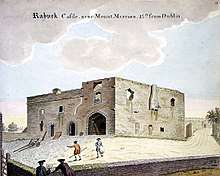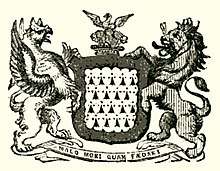Roebuck, Dublin
Roebuck, also originally known as "Rabuck", was an estate and townland in the baronys of Dublin, Uppercross, and Rathdown in Ireland.


Roebuck became established as a location shortly after the Norman invasion of Ireland (from 1169). In 1261, it was owned by Fromund Le Brun, the Lord Chancellor of Ireland, and a castle was built there in the 13th century which was badly damaged in the Irish Rebellion of 1641. It was pictured by Gabriel Beranger around 1768. It was sold by Nicholas Barnewall, 14th Baron Trimlestown, to James Crofton, an official of the Irish Treasury, in around 1800.[3]
In 1466, Elizabeth le Brun married Robert Barnewall, 1st Baron of Trimlestown. The Irish Civil Survey of 1654-56 recorded that the estate consisted of around 500 acres. It remained in the hands of the Trimlestown family until the early nineteenth century when parts were sold off.[3] The surgeon Solomon Richards acquired land in the area of the estate known as Roebuck Grove from Baron Trimlestown in 1812.[3][2]
The estate was acquired by the Westby family in 1856 and from 1943 until 1985 it was owned by the Little Sisters of the Poor. It later became part of the University College Dublin campus.[3]
See also
References
- Rabuck (Roebuck) Castle, near Mount Merrion. National Library of Ireland. Retrieved 4 June 2018.
- Burke, Bernard. (1871). A Genealogical and Heraldic History of the Landed Gentry of Great Britain & Ireland. II (5th ed.). London: Harrison. pp. 1163–64.
- Origins of the Belfield Campus and UCD’s Period Houses Map and Guide. University College Dublin, Dublin, 2012.
External links

- http://humphrysfamilytree.com/Barnewall/nicholas.crickstown.html